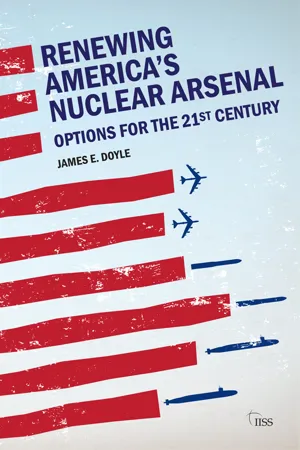![]()
Chapter One
The plan for a trillion-dollar triad
The US plans to renew its nuclear triad – its fleet of nuclear bombers, ballistic-missile submarines, and land-based ICBMs and their nuclear warheads – in full in the coming years. The airborne part of the nuclear force will retain some B-52 and B-2 bombers but will largely consist of 100 new B-21 strategic aircraft (although not all of them may be produced for nuclear missions), equipped with more than 1,000 new nuclear-armed cruise missiles as well as upgraded bombs. The land-based leg will consist of 400 new ICBMs to replace the existing Minuteman III missiles. The seaborne leg of the triad will rest on 12 new Columbia-class SSBNs. Seven types of nuclear warhead will be part of the nuclear arsenal in support of these new delivery platforms.
Strategic aircraft and cruise missiles
In October 2015 the US Air Force awarded a contract to procure a new, nuclear-armed, long-range penetrating strike bomber (designated the B-21 Raider) to Northrop Grumman. It is estimated that the 100 new aircraft ordered will cost in excess of US$80bn and enter service from 2025,1 with production potentially continuing beyond 2030. It is uncertain how many of these new strategic aircraft will be equipped for nuclear missions.
As the new B-21 aircraft are delivered, the older B-52 and B-1 bombers will be retired, although some of these planes will remain in service until 2040 or beyond, as will the 20 B-2 strategic aircraft. The current plans call for the B-21 aircraft to be equipped to carry the B61-12 guided nuclear bomb and a new long-range nuclear-armed cruise missile (currently designated the Long-Range Standoff Weapon–LRSO). If the new B-21 bombers are available as planned in 2025, they may be equipped with the existing AGM-86B nuclear air-launched cruise missile (ALCM) until that missile is retired sometime after 2030 and replaced by the LRSO.2
The proposed LRSO nuclear-armed cruise missile is the second major procurement programme for the air-breathing leg of the nuclear triad in the next 30 years. Current plans call for the acquisition of 1,000–1,100 missiles at a projected cost of US$9bn (the nuclear warhead for these missiles will cost at least US$10bn–15bn). The new missiles are to enter service in 2025 and remain operational for at least 30 years. Full-scale development is planned to begin in 2017, with US$1.8bn allocated up to 2020.3
Land-based ICBMs
The US land-based ICBM force currently consists of 450 Minuteman III ICBMs, each deployed with one warhead. By early February 2018 the fleet will decline to 400 deployed missiles, while retaining all 450 launchers, in accordance with the New START Treaty. The Air Force has also undertaken a modernisation programme for the Minuteman III missiles, replacing and upgrading their rocket motors, guidance systems and other components, to extend their service lives until 2030.4
The current modernisation plans call for the replacement of 400 Minuteman III nuclear ICBMs with new missiles, beginning in 2027. A preliminary estimate completed in February 2015 by the Air Force Nuclear Weapons Center’s ICBM System Program Office put the acquisition cost of the Minuteman III replacement system – an option studied under the Pentagon’s Ground-Based Strategic Deterrent (GBSD) programme – at US$62.3bn,5 covering a 30-year period between the fiscal years 2015 and 2044. Debate continues on the actual cost of the ICBM replacement plan, with some estimates as high as US$120bn for the new missiles.6 The 2015 cost estimates for the GBSD programme have already been revised upwards. The Pentagon’s Office of Cost Assessment and Program Evaluation in May 2017 produced a low-end estimate of US$85bn to replace the Minuteman III ICBMs, more than one-third higher than the Air Force’s figure.7
The Air Force completed an analysis of alternatives for the ICBM force that was briefed to industry officials in July 2014. It plans to maintain the basic design of the Minuteman III, its communications system and launch silos, but would replace the rocket motors, guidance sets, post-boost vehicles and re-entry systems. This means the Air Force would effectively deploy a new missile in the current Minuteman infrastructure. Reports also indicate that, although this missile would be deployed in fixed silos, the design would allow it to be deployed on mobile launchers in the future, a basing mode that would add signifi-cant cost.
Ballistic-missile submarines
The US Navy is currently conducting development and design work on the new Columbia class of ballistic-missile submarines. This new submarine is planned to replace the Ohio-class Trident nuclear submarines as they reach the end of their service lives from 2027. However, it is estimated that the first new vessel will enter the fleet in 2031, meaning that the number of SSBNs is expected to decline to ten for most of the 2030s. The Navy is designing the new submarines with only 16 ballistic-missile launch tubes as part of cost-saving efforts. The Trident submarines have 24 launch tubes, and each currently carries 24 missiles, although the Navy plans to reduce this to 20 on each submarine by the end of 2017 as the US downsizes its forces to comply with New START.
The Navy has estimated that, in 2014 dollars, the 12-boat Columbia fleet will cost US$139bn. It expects the first submarine to cost US$14.5bn, comprising US$8.8bn in construction costs and US$5.7bn in non-recurring engineering work. Subsequent submarines are expected to cost US$9.8bn.8
Nuclear warheads
The US nuclear-weapons stockpile is composed of seven different types of warhead. Current plans call for the modernisation (life extension) of several of these types during the next 20–40 years. The US DoE’s National Nuclear Security Administration (NNSA) conducts this work in its network of national laboratories and production sites. The costs of nuclear-warhead maintenance and modernisation must be added to the DoD’s nuclear-weapons expenditure to calculate the total cost of US nuclear forces. US nuclear ...
